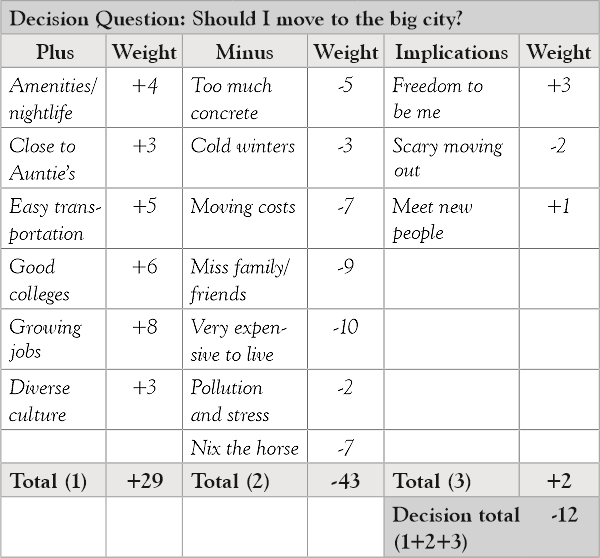That is the question! Typically, the question is obvious. It’s how to go about making a wise decision that’s not always clear. To reduce uncertainty and doubt, Ben Franklin suggested a powerful tool that can help you make more confident choices.
A revolutionary idea!
Ben Franklin’s method (also known as the weighted pros & cons method) is useful in situations where there’s only one alternative and many factors to consider. In other words, “yes-no”, “go-no go”, or “to be-not to be” type questions. The method was described by Benjamin Franklin in a 1772 letter to his friend, English scientist Joseph Priestly (the discoverer of oxygen).
According to Franklin, “though the weight of the pluses and minuses cannot be taken with the precision of algebraic quantities, yet when each is thus considered, separately and comparatively, and the whole lies before me, I think I can judge better, and am less liable to take a rash step.” You’ll find many opportunities where you can use this practical tool to your advantage!
Making decisions like Ben Franklin.
Franklin’s cost-benefit analysis is useful to assess thorny “yes-no” type questions such as, “Should I take this job?” or “Should I move to the big city?” The problem, notes Dr. Franklin, is “all the reasons, both for and against, are not present to our mind at the same time.” Under pressure to decide, we may neglect to consider some critical factors. Also, some reasons may be less important than others.
 Like a pendulum, we mentally swing back and forth, swayed by impulses that muddle our thinking and cloud our judgment. Franklin solves this by encouraging us to be more thorough in our analysis and to think about the decision over time. He extends the Pros & Cons format (see: Every pizza is a personal pizza) with three refinements. Here they are:
Like a pendulum, we mentally swing back and forth, swayed by impulses that muddle our thinking and cloud our judgment. Franklin solves this by encouraging us to be more thorough in our analysis and to think about the decision over time. He extends the Pros & Cons format (see: Every pizza is a personal pizza) with three refinements. Here they are:
- List the factors over time.
Not all our thoughts occur to us at a particular point in time or even necessarily when we consciously try to list them. List the pros, cons, and implications as they come to mind over a period of time—and this is important—not at a single sitting. Reflect on the decision you face and then add to (or subtract from) your pros and cons lists. - Weight the pros and cons.
Assess the importance of a factor by assigning it a number that ranges from 1 (not at all important) to 10 (extremely important). The weights in the Plus column are assigned a plus (+) sign and those in the Minus column are assigned a minus (–) sign. Weights for implications can be either plus or a minus, depending on whether you feel that they positively or negatively influence the decision question. - Balance and review.
Add the weights in each column and write the totals at the bottom. Mindful of signs, add the column totals and calculate the decision total. Finally, scan the pros, cons, and implications listed, being especially attuned to your subjective weightings. Take stock of what the totals tell you and try to get a “gut feel” for the overall balance:- A set of pros and cons clearly skewed in favor of the pluses might indicate that you should go ahead with the decision. Likewise, a set that is clearly skewed in favor of the minuses might suggest that you should avoid taking this action.
- A roughly balanced set of pluses and minuses suggests a difficult decision, one with no clear basis for committing to or foregoing the course of action. You might need to give more thought to the factors and their weightings or check with a tribal elder. Alternatively, you may conclude that now is not the time to decide.
Here’s how it works.
Decision question: Tracy asks, “Should I move to the big city?”
Pros:
- The amenities and the night life!….(+4)
- One-hour drive from Auntie’s house….(+3)
- Public transportation makes it easier to get to places I want to go….(+5)
- Great community college system….(+6)
- Growing region for jobs in my field….(+8)
- Open and diverse culture….(+3)
Total Pros = +29
Cons:
- Where did all the grass go?….(–5)
- Winters are cold and clammy….(–3)
- Cost of moving from home will be substantial….(–7)
- Will miss my family and friends….(–9)
- Very expensive—may have to live in low-rent district to afford….(–10)
- More pollution and stress….(–2)
- Will have to give up my horse….(–7)
Total Cons = –43
Implications:
- Freedom to start my own life! ….(+3)
- The prospect of moving out on my own is a little scary….(–2)
- Meet more people….(+1)
Total Implications = +2
Final decision total = (+29) + (–43) + (+2) = –12

A strongly positive score indicates that action should be taken; if strongly negative, it should be avoided. A moderate score suggests a compromise or taking no action at this time. For Tracy, the security and comforts of a settled rural existence outweigh the call of the “bright lights.” After conferring with two tribal elders (her mom and her aunt), she decided it would be better for her to live outside the city near her Aunt, but close enough to commute if necessary.
Did you ever have to make up your mind?
~ The Lovin’ Spoonful, American pop rock group
Learn more about this, and other interesting topics, in the Young Person’s Guide to Wisdom, Power, and Life Success.
Image credit: “Pretty young woman making a decision” by Rancz Andrei, licensed from 123rf.com (2017).





















